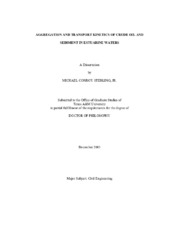| dc.description.abstract | Modeling the transport and fate of spilled crude oil is important for estimating short and long-term toxicity effects in coastal ecosystems. This research project investigates the partitioning of hydrocarbons from a surface crude oil slick, the resurfacing of chemically dispersed crude oil droplets, the suitability of in-situ field instruments for oil and sediment characterization, and the aggregation and settling of dispersed oil and suspended sediments.
An initial laboratory study was conducted to investigate apparent hydrocarbon solubility in petroleum/water systems. Mixing shear and initial crude oil layer thickness were related empirically to oil entrainment rate. A model describing hydrocarbons partitioned in colloidal and soluble phases was consistent with experimental data. A second laboratory study was conducted to investigate the influence of coalescence kinetics on mean droplet size and resurfacing rate of chemically dispersed crude oil droplets. Increased mean shear rates resulted in mean droplet diameters and oil resurfacing rates. A third laboratory study was conducted to compare particle size and fractal dimension measurements obtained using a submersible flow cytometer, an electrozone particle counter, and a light scattering particle sizer. Measured particles included latex beads, crude oil, clay, crude oil-clay aggregates, and crude oil-silica aggregates. Tested instruments gave consistent size measurements for all particle systems, suggesting their suitability for sizing marine particles.
To describe the aggregation kinetics of oil-sediment systems, a modified Smoluchowski model based on coalesced sphere (CS) assumptions was developed. Observed collision efficiency values (αOBS) were related to collision efficiency values for single particle type systems (αHOMO) and those for two particle type systems (αHET) using a probabilistic approach. For clay and crude oil, αHOMO values were higher than the αHOMO value for silica. Clay-oil and silica-oil have similar αHET values. Thus, crude oil can significantly increase the aggregation rates of noncohesive sediments such as silica.
The CS model above was modified to incorporate sediment fractal geometry. The ability of this modified coalesced fractal sphere (mCFS) model to fit experimental data sets was better than that of a coalesced sphere (CS) model. Because of their reduced settling rates, sediments with lower fractal dimension form more aggregate with dispersed oil. | en |


